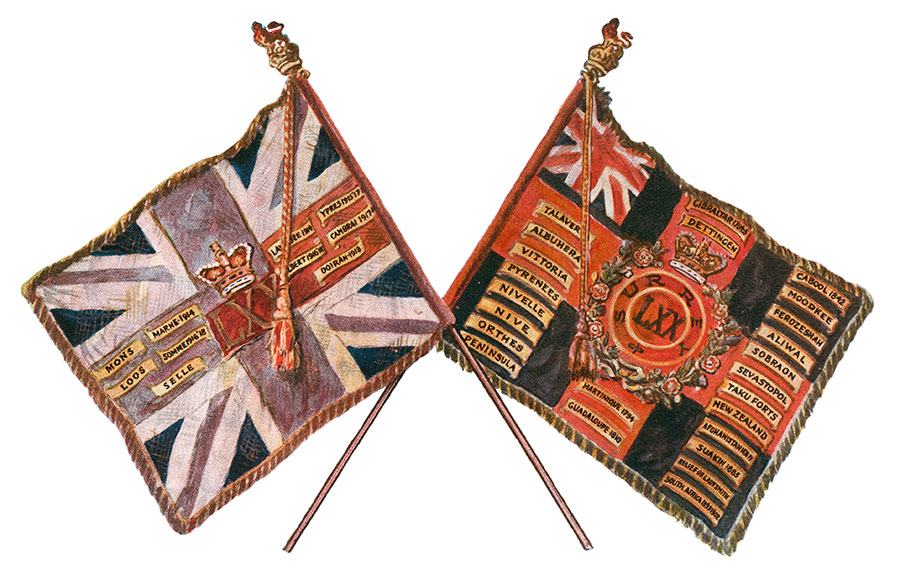The Colours of The East Surrey Regiment
(and its forebears the 31st and 70th of Foot)
The Seventieth Regiment 1867-1881
and 2nd Battalion the East Surrey Regiment (70th Foot) 1881-1945
The Seventieth returned from active service in New Zealand in 1866. These Colours were presented to the Seventieth at Aldershot by Lady Scarlett, wife of the GOC, Sir James Scarlett of Balaclava Heavy Brigade fame, in August 1867. They were carried for seventy-eight years, at one time being among the oldest in the British Army. They seem to have anticipated the Queen’s regulation of 1868 (or else they were later altered), which ordered the final reduction in size of Colours to three feet nine inches horizontally by three feet vertically. Like its predecessors, the Regimental Colour bore the red cross of St George on a black field. A rather large LXX, set on a piece of red cloth on the faded central red cross, would appear to be a later renovation on the Queen’s Colour.
The Battle Honours borne on the Regimental Colour of the 70th at the time of the formation of The East Surrey Regiment were:
MARTINIQUE 1794 |
GUADALOUPE 1810 |
NEW ZEALAND |
AFGHANISTAN 1878-79 |
After a successful tour of duty in Ireland, the 70th served in India from 1872 to 1884, during which period the reorganisation of Line Infantry, on a territorial basis, took place. As a result the 70th became the 2nd Surreys. Active service in the Second Afghan War of 1878-1879, which was the last time the Colours were carried in action, and against the Mahdi in Suakin in 1885 was followed by a short tour in Malta 1893-1895. The Colours accompanied the Battalion to South Africa where Spion Kop and Colenso may be mentioned among the many actions in which the battalion was involved, with a loss of 290 killed and wounded.
In these years, the 2nd Surreys added the following Battle Honours to the Colours:
SUAKIN 1885 |
RELIEF OF LADYSMITH |
SOUTH AFRICA 1899-1902 |
|
The Colours remained in England throughout the Great War, and because of their age, were naturally held in great esteem.
When the 2nd Battalion went to serve in the Far East in 1938, the Colours went with them, and as the Japanese threatened Singapore, they were placed with the silver in the vaults of the Hong Kong and Shanghai Bank. As the enemy came nearer it was suggested that the Colours should be sent home, but the Commanding Officer ordered they should remain and take their chance with the battalion. During the occupation, the Japanese evidently had examined these, by now, much faded flags and had thrown them on the floor of the bank vault, where they were found in August 1945. Colonel FAH Magee, who had carried the Regimental Colour as a subaltern at the trooping ceremony in Jersey in 1925, recalled the events of 1945:
“At the end of September 1945, after the Japanese surrender, but while we ex-POWs were still confined in Changi gaol awaiting repatriation, Lt Col Jack Stitt, 2nd Gordons, told me that he had visited the vaults of the bank to see if he could trace his Regimental silver, which had been placed there during hostilities, and had seen some of ours lying about as well as our Colours. I immediately sought permission to visit the town, as I was due to embark for Britain next day. Taking Captain Dick Underwood, 1st Leicesters, who was my staff captain and had been with me throughout our time in Changi, I went to the bank where I saw the Surreys Colours lying on the floor of one of the vaults having been torn off their pikes but otherwise undamaged . . . as we had to return to Changi straight away I sent a signal to HMS Nelson asking them to collect our silver and the Colours from the bank and deliver to the Regimental Depot in due course. . .” |
Having been duly returned, they were marched onto parade, furled, at West Chiltington Camp, near Pulborough, on 30th November 1945, by a Colour Party made up of recently repatriated members of the original 2nd Battalion (including Colonel Magee) which had lost over 300 men during the fighting in the Malayan campaign and later as prisoners of war. The Colours were then trooped in slow time through the new, re-constituted battalion, and being re-furled after the General Salute were marched to the rear of the parade to the tune of ‘Auld Lang Syne’. This famous old pair of Colours are now beautifully framed and exhibited at Clandon Park.
| Figure 54 | Figure 55 | |
| (Click to enlarge) | ||
Related

